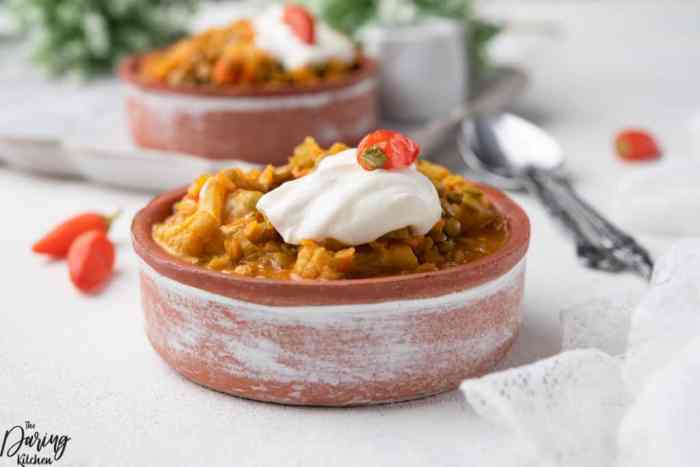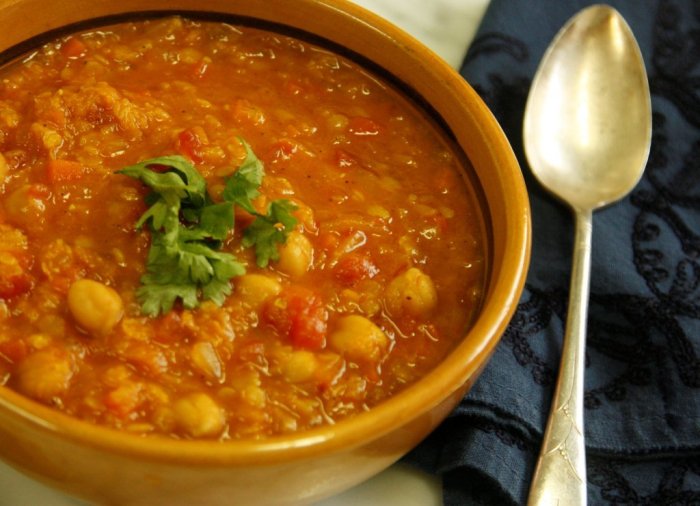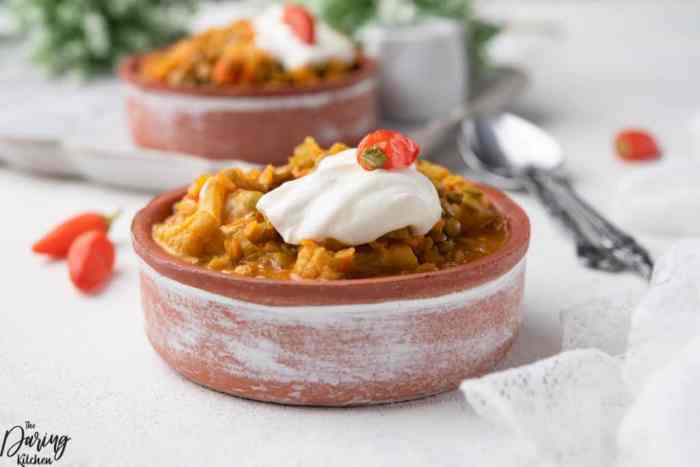
Moroccan Lentil Soup with Veggies: A Flavorful Journey
Moroccan lentil soup with veggies is a hearty and flavorful dish that embodies the rich culinary traditions of Morocco. This soup is a staple in Moroccan cuisine, cherished for its comforting warmth, nutritional value, and vibrant blend of spices. From the humble lentil to the aromatic blend of cumin, coriander, and turmeric, each ingredient plays a vital role in creating a symphony of flavors that tantalizes the taste buds.
The history of lentil soup in Morocco dates back centuries, deeply intertwined with the country’s cultural heritage. This dish has been a source of sustenance and nourishment for generations, passed down through families and shared at gatherings and celebrations. Its versatility allows for endless variations and adaptations, reflecting the diverse culinary landscape of Morocco.
Introduction to Moroccan Lentil Soup
Moroccan lentil soup, known as “Harira,” is a staple dish in Moroccan cuisine, deeply rooted in tradition and culture. This hearty and flavorful soup is a testament to the country’s rich culinary heritage, showcasing the harmonious blend of spices, vegetables, and legumes.
The History of Moroccan Lentil Soup
Moroccan lentil soup has a long and storied history, dating back centuries. It is believed to have originated in the Berber culture, the indigenous people of North Africa, who were known for their resourceful use of readily available ingredients. Lentils, a highly nutritious and affordable legume, were a staple food source, and the soup evolved as a nourishing and satisfying meal for people of all walks of life.
Cultural Significance of Moroccan Lentil Soup
Moroccan lentil soup holds a special place in Moroccan culture, symbolizing warmth, comfort, and hospitality. It is traditionally served during Ramadan, the Muslim holy month of fasting, as a nourishing and filling meal for breaking the fast. It is also a popular dish during special occasions and gatherings, bringing families and communities together.
Ingredients and Flavors of Moroccan Lentil Soup
Moroccan lentil soup is known for its unique and complex flavor profile, achieved through a careful combination of ingredients. The soup typically includes:
- Lentils:The star ingredient, lentils provide a hearty and protein-rich base for the soup.
- Tomatoes:Tomatoes add sweetness, acidity, and a vibrant red color to the soup.
- Onions:Onions provide a savory base and a hint of sweetness.
- Garlic:Garlic adds a pungent aroma and flavor to the soup.
- Ginger:Ginger adds a warm and spicy note to the soup.
- Cumin:Cumin adds a warm, earthy flavor to the soup.
- Paprika:Paprika adds a sweet and smoky flavor to the soup.
- Turmeric:Turmeric adds a bright yellow color and a slightly bitter flavor to the soup.
- Cilantro:Cilantro adds a fresh and herbaceous flavor to the soup.
- Lemon Juice:Lemon juice adds a bright and tangy flavor to the soup.
- Olive Oil:Olive oil adds richness and depth of flavor to the soup.
The combination of these ingredients creates a rich and complex flavor profile, with a balance of sweet, savory, spicy, and tangy notes.
Ingredients and Preparation
This comforting soup is a testament to the vibrant flavors of Moroccan cuisine. It’s a simple yet delicious dish that can be made with pantry staples and fresh ingredients. Let’s dive into the essential components and the steps involved in crafting this aromatic and satisfying soup.
Moroccan lentil soup with veggies is a hearty and comforting meal, perfect for a chilly evening. The rich flavors of cumin, turmeric, and ginger are balanced by the sweetness of carrots and the earthiness of lentils. For a protein boost, try pairing it with a thai style grilled pork tenderloin , which adds a smoky and tangy element to the meal.
The combination of the warm soup and the savory grilled pork is a satisfying and flavorful experience.
Ingredients
The heart of any Moroccan lentil soup lies in its carefully chosen ingredients.
- Lentils:The foundation of this soup is green lentils, known for their earthy flavor and ability to hold their shape during cooking. Brown lentils can also be used, but they tend to break down more during the cooking process.
- Vegetables:A medley of vegetables adds depth and texture to the soup. Common additions include carrots, onions, celery, and potatoes. You can also incorporate other vegetables like zucchini, turnips, or sweet potatoes for added variety.
- Spices:The magic of Moroccan cuisine lies in its spices. This soup typically features cumin, turmeric, paprika, ginger, and cinnamon. These spices work together to create a warm and complex flavor profile.
- Tomato Paste:A dollop of tomato paste adds a touch of sweetness and acidity to the soup, enhancing its overall flavor.
- Broth or Water:Vegetable broth is ideal for creating a rich and flavorful soup, but water can also be used.
- Lemon Juice:A squeeze of lemon juice adds a bright and tangy touch, balancing the richness of the soup.
- Fresh Herbs:A sprinkle of fresh cilantro or parsley adds a burst of freshness and aroma to the soup.
Preparation
The process of making Moroccan lentil soup is straightforward and rewarding.
- Sauté the Vegetables:Begin by sautéing chopped onions, carrots, and celery in olive oil until softened. This step helps to release the natural sweetness of the vegetables and create a flavorful base for the soup.
- Add the Spices:Stir in cumin, turmeric, paprika, ginger, and cinnamon. Allow the spices to bloom for a minute or two, releasing their fragrant aromas.
- Incorporate the Lentils:Add the green lentils and tomato paste to the pot. Stir well to coat the lentils with the spices and vegetables.
- Pour in the Broth:Add vegetable broth or water to the pot, ensuring the lentils are fully submerged. Bring the mixture to a boil, then reduce heat and simmer for about 30-40 minutes, or until the lentils are tender but still hold their shape.
- Season and Adjust:Taste the soup and adjust the seasoning with salt and pepper as needed. Add a squeeze of lemon juice for a bright and tangy touch.
- Garnish and Serve:Garnish the soup with fresh cilantro or parsley before serving. You can enjoy the soup as is or top it with a dollop of yogurt or a sprinkle of toasted almonds for added flavor and texture.
Spices in Moroccan Lentil Soup
The spices used in Moroccan lentil soup are not just for flavor; they contribute to its distinct character and health benefits.
“Moroccan cuisine is known for its vibrant use of spices, and lentil soup is no exception. The combination of cumin, turmeric, paprika, ginger, and cinnamon creates a warm, earthy, and slightly sweet flavor profile that is both comforting and invigorating.”
- Cumin:Known for its earthy and slightly bitter flavor, cumin adds depth and warmth to the soup. It also has digestive benefits.
- Turmeric:This spice is renowned for its anti-inflammatory properties and golden hue. It adds a warm, slightly peppery flavor to the soup.
- Paprika:Paprika brings a touch of sweetness and a vibrant red color to the soup. It also adds a mild heat that complements the other spices.
- Ginger:This spice is known for its digestive benefits and its warm, pungent flavor. It adds a layer of complexity to the soup.
- Cinnamon:Cinnamon adds a touch of sweetness and warmth to the soup. It also has antioxidant properties.
Variations and Adaptations

Moroccan lentil soup, with its rich flavors and hearty texture, is a dish that lends itself beautifully to variations and adaptations. You can experiment with different ingredients, cooking techniques, and dietary preferences to create a unique and delicious soup that suits your taste.
Regional Variations
Regional variations in Moroccan lentil soup often reflect the availability of local ingredients and culinary traditions. For example, in the coastal regions, seafood such as fish or shellfish may be added to the soup, while in the mountainous regions, lamb or beef might be preferred.
- Coastal Regions:In coastal areas, the soup may include fresh seafood like fish, shellfish, or even squid, adding a briny and savory dimension to the dish.
- Mountainous Regions:In mountainous areas, lamb or beef is commonly used as a protein source, adding a richer and more robust flavor to the soup.
- Southern Regions:In southern Morocco, the soup may be flavored with harissa, a spicy chili paste, adding a fiery kick to the dish.
Alternative Ingredients and Substitutions
Moroccan lentil soup is a versatile dish that allows for experimentation with different ingredients and substitutions.
Lentils
- Green Lentils:These lentils hold their shape well during cooking, adding a pleasant texture to the soup.
- Brown Lentils:These lentils are a good source of fiber and protein and cook quickly, making them a convenient option.
- Red Lentils:These lentils cook quickly and break down easily, creating a creamy texture in the soup.
Vegetables
- Carrots:Carrots add sweetness and a vibrant color to the soup.
- Celery:Celery adds a subtle earthy flavor and a crisp texture to the soup.
- Turnips:Turnips provide a slightly sweet and peppery flavor to the soup.
- Sweet Potatoes:Sweet potatoes add a touch of sweetness and a creamy texture to the soup.
- Spinach:Spinach adds a boost of nutrients and a vibrant green color to the soup.
Dietary Adaptations, Moroccan lentil soup with veggies
Moroccan lentil soup can be easily adapted to meet various dietary needs.
Vegetarian and Vegan Options
The traditional Moroccan lentil soup recipe is already vegetarian, as it does not include any meat or poultry. To make it vegan, simply omit any animal-based ingredients, such as honey or butter.
Gluten-Free Options
To make the soup gluten-free, use gluten-free vegetable broth and ensure that all other ingredients are gluten-free.
Moroccan lentil soup with veggies is a hearty and comforting meal, perfect for a chilly evening. The earthy flavors of the lentils are balanced by the bright acidity of the lemon and the sweetness of the vegetables. And for a truly satisfying experience, I highly recommend pairing it with a slice of Sybil’s Old Fashioned Lemon Layer Cake.
The cake’s delicate citrus notes complement the soup’s earthy flavors, creating a symphony of taste in your mouth. It’s a perfect combination that will leave you feeling warm and satisfied.
Dairy-Free Options
To make the soup dairy-free, simply omit any dairy ingredients, such as butter or yogurt.
Low-Sodium Options
To reduce the sodium content of the soup, use low-sodium vegetable broth and avoid adding salt during the cooking process.
Low-Fat Options
To reduce the fat content of the soup, use lean ground beef or lamb, and avoid adding butter or oil during the cooking process.
Serving and Presentation: Moroccan Lentil Soup With Veggies
Moroccan lentil soup is typically served warm, often as a hearty and comforting meal. Its rich flavors and satisfying texture make it a perfect dish for any occasion, from a casual weeknight dinner to a more formal gathering.
Moroccan lentil soup with veggies is a hearty and flavorful dish that’s perfect for a chilly evening. The earthy lentils and fragrant spices create a comforting aroma that fills the kitchen. If you’re looking for a protein-rich accompaniment, consider pairing the soup with some juicy pork rub rubbed and baked pork chops.
The smoky flavor of the pork complements the warmth of the soup beautifully, making for a satisfying and well-balanced meal.
Serving Suggestions
Traditionally, Moroccan lentil soup is served in deep bowls, allowing the aromas to waft up as you savor each spoonful. The soup is often garnished with fresh herbs, such as parsley, cilantro, or mint, adding a burst of freshness and color.
A drizzle of olive oil or a squeeze of lemon juice can enhance the flavors and add a touch of acidity.
Accompanying Dishes
Moroccan lentil soup pairs well with a variety of accompanying dishes. Here are some ideas:
- Warm Bread:A crusty loaf of bread, such as Moroccan khobz, is perfect for dipping into the soup and soaking up the flavorful broth.
- Side Salads:A refreshing side salad with ingredients like tomatoes, cucumbers, onions, and a simple vinaigrette can balance the richness of the soup.
- Couscous:A traditional accompaniment in Moroccan cuisine, couscous can be served alongside the soup for a complete meal.
- Tagine:A Moroccan stew, often featuring meat and vegetables, can be served alongside the soup for a more elaborate meal.
Presentation Tips
To make your Moroccan lentil soup visually appealing, consider these presentation tips:
- Garnish:Use fresh herbs, a sprinkle of paprika, or a drizzle of olive oil to add color and visual interest.
- Serve in Attractive Bowls:Choose bowls that complement the colors and textures of the soup.
- Presentation Plate:Serve the soup in a bowl placed on a decorative plate to enhance the presentation.
Nutritional Value and Benefits

Moroccan lentil soup is not only a delicious and satisfying meal but also a nutritional powerhouse. This hearty soup is packed with essential vitamins, minerals, and fiber, making it a healthy and fulfilling choice.
Nutritional Content of Moroccan Lentil Soup
The nutritional content of Moroccan lentil soup varies depending on the specific ingredients and quantities used. However, a typical serving of this soup provides a significant amount of protein, fiber, iron, folate, and other essential nutrients.
Lentils
Lentils are a nutritional powerhouse, providing a rich source of protein, fiber, and various vitamins and minerals. They are an excellent source of plant-based protein, containing about 18 grams of protein per cooked cup. This makes lentils a valuable addition to a vegetarian or vegan diet.
Lentils are also high in fiber, which aids in digestion, helps regulate blood sugar levels, and promotes satiety.
Vegetables
The vegetables used in Moroccan lentil soup, such as carrots, onions, and tomatoes, contribute to its nutritional value. Carrots are rich in vitamin A, which is essential for vision, skin health, and immune function. Onions are a good source of vitamin C, an antioxidant that supports the immune system.
Tomatoes are a source of lycopene, a powerful antioxidant linked to a reduced risk of certain cancers.
Health Benefits of Moroccan Lentil Soup
Moroccan lentil soup offers a range of health benefits due to its nutrient-rich ingredients.
Heart Health
The high fiber content of lentils and vegetables in Moroccan lentil soup can help lower cholesterol levels, which is beneficial for heart health. Fiber helps bind cholesterol in the digestive tract, preventing its absorption into the bloodstream.
Blood Sugar Control
The fiber in lentils and vegetables helps regulate blood sugar levels by slowing down the absorption of sugar into the bloodstream. This can be particularly beneficial for individuals with diabetes or those seeking to manage their blood sugar levels.
Weight Management
Moroccan lentil soup can be a valuable addition to a weight management plan. The high fiber content promotes satiety, helping you feel fuller for longer and reducing overall calorie intake. The soup is also relatively low in calories, making it a satisfying and healthy meal option.
Digestive Health
The fiber in lentils and vegetables promotes digestive health by adding bulk to stools and facilitating regular bowel movements. Fiber also supports the growth of beneficial bacteria in the gut, contributing to overall gut health.
Cultural Significance and Tradition
Moroccan lentil soup, affectionately known as “Harira,” holds a special place in Moroccan culture, transcending its role as a simple meal. It’s a dish deeply intertwined with social gatherings, religious observances, and the transmission of culinary heritage through generations.
Social Significance of Harira
Harira is a staple dish during Ramadan, the Islamic holy month of fasting. It’s traditionally consumed at the end of each day’s fast, providing sustenance and energy after a long day of abstaining from food and drink. Its rich and comforting flavors, along with its ability to warm the body and soul, make it an ideal meal for breaking the fast.
Beyond Ramadan, Harira is also served at weddings, celebrations, and other special occasions, symbolizing hospitality, abundance, and shared joy.
Traditional Recipes and Techniques
Moroccan lentil soup recipes have been passed down through generations, with each family adding its unique touch. While the basic ingredients remain consistent, the specific spices, herbs, and cooking techniques vary depending on the region and family traditions. Some families use a slow-cooked method, allowing the flavors to meld and deepen over time.
Others prefer a quicker method, using a pressure cooker to shorten the cooking time.
“The art of making Harira lies not only in the ingredients but also in the love and care poured into its preparation.”
Moroccan proverb
Stories and Anecdotes
The cultural significance of Harira is reflected in numerous stories and anecdotes passed down through generations. One such story tells of a young woman who was preparing Harira for her family’s Ramadan feast. She had meticulously followed her grandmother’s recipe, but the soup lacked the depth of flavor she remembered from her childhood.
As she pondered the reason, her grandmother appeared in her dreams, revealing that the missing ingredient was a pinch of love. From that day forward, the woman always added a touch of love to her Harira, ensuring its flavors were as rich and comforting as her grandmother’s.
Recipes and Cooking Tips
Moroccan lentil soup is a versatile dish that can be adapted to suit your taste and dietary needs. Here, we’ll explore three different recipes, each offering a unique flavor profile and level of complexity. We’ll also provide cooking tips to ensure you achieve the perfect texture and taste for each recipe.
Recipes and Cooking Tips
This section presents three different recipes for Moroccan lentil soup, varying in complexity and ingredients. Each recipe is accompanied by specific cooking tips to help you achieve the best flavor and texture.
| Recipe Name | Ingredients | Instructions | Serving Suggestions |
|---|---|---|---|
| Classic Moroccan Lentil Soup |
|
|
|
| Moroccan Lentil Soup with Vegetables |
|
|
|
| Moroccan Lentil Soup with Harissa |
|
|
|
Cooking Tips:
- For a richer flavor, sauté the onions and garlic in a little butter or ghee instead of olive oil.
- To enhance the soup’s texture, add a handful of chopped spinach or kale in the last 5 minutes of cooking.
- If you prefer a smoother soup, use an immersion blender to blend a portion of the soup after cooking.
- For a spicier soup, add more cayenne pepper or a pinch of chili flakes.
- Feel free to experiment with different vegetables, such as sweet potatoes, chickpeas, or green beans.
Visual Representation
A visual representation of Moroccan lentil soup can be a powerful tool to understand the dish’s essence. From the vibrant colors of the ingredients to the final comforting bowl, every step paints a picture of this culinary masterpiece.
Ingredient Visuals
Visualizing the ingredients is crucial to understand the essence of the dish. Imagine a colorful array of ingredients, each playing a distinct role.
- Lentils:A rich brown lentil variety, known for its earthy flavor and ability to absorb the surrounding flavors.
- Onions:Golden-brown onions, their sweet aroma adding depth to the soup.
- Carrots:Vibrant orange carrots, providing a sweet and earthy counterpoint to the lentils.
- Tomatoes:Juicy, red tomatoes, their tangy sweetness adding complexity to the broth.
- Garlic:Aromatic garlic cloves, adding a pungent and earthy flavor to the soup.
- Ginger:A small piece of ginger, its subtle, spicy flavor adding a warming touch.
- Cumin:A teaspoon of cumin powder, its earthy and warm aroma infusing the soup with depth.
- Turmeric:A pinch of turmeric, its bright yellow hue adding color and a hint of bitterness.
- Paprika:A sprinkle of paprika, its sweet and smoky flavor adding a touch of complexity.
- Olive Oil:A generous drizzle of olive oil, adding richness and depth to the soup.
- Vegetable Broth:A flavorful broth, providing the base for the soup and enriching its taste.
- Fresh Herbs:A handful of fresh cilantro and parsley, their vibrant green hues adding a refreshing touch and a burst of flavor.
- Lemon Juice:A squeeze of fresh lemon juice, adding a bright and tangy acidity that balances the richness of the soup.
Preparation Process
Visualizing the preparation process is essential for understanding the dish’s journey from raw ingredients to a comforting bowl. Imagine a step-by-step visual guide that showcases the transformation of the ingredients.
- Sautéing the Aromatics:Imagine a sizzling pan filled with olive oil, onions, garlic, and ginger. The aromas fill the air as they soften and release their flavors. The onions turn golden brown, and the garlic and ginger infuse the oil with their pungent aroma.
- Adding the Spices:Visualize the addition of cumin, turmeric, and paprika to the pan. The spices dance in the hot oil, releasing their aromas and adding depth to the dish.
- Adding the Lentils and Tomatoes:Picture the lentils being added to the pan, followed by the chopped tomatoes. The lentils soak up the flavors of the spices and the tomatoes release their sweet and tangy juices, creating a flavorful base for the soup.
- Adding the Broth:Imagine the vegetable broth being poured into the pan, covering the lentils and tomatoes. The broth begins to simmer, creating a comforting aroma that fills the kitchen.
- Simmering and Seasoning:Visualize the soup simmering gently, the lentils softening and absorbing the flavors of the broth and spices. Imagine adding salt and pepper to taste, balancing the flavors and enhancing the dish’s complexity.
- Adding the Greens:Picture the fresh cilantro and parsley being added to the soup just before serving. Their vibrant green hues add a refreshing touch, and their flavors brighten the dish.
- Finishing Touches:Imagine a squeeze of lemon juice adding a bright and tangy acidity to the soup, balancing the richness of the lentils and spices.
Visual Presentation
The visual presentation of Moroccan lentil soup is just as important as its taste. Imagine a steaming bowl of soup, garnished with fresh herbs and a drizzle of olive oil.
- Color:The soup has a rich, earthy color, with hints of orange from the carrots and green from the herbs.
- Texture:The lentils are soft and creamy, creating a comforting texture. The vegetables add a pleasant crunch, providing a textural contrast.
- Garnish:A sprinkle of fresh cilantro and parsley adds a pop of color and a burst of flavor.
- Serving:The soup is typically served in a deep bowl, allowing the aromas to fill the air.






